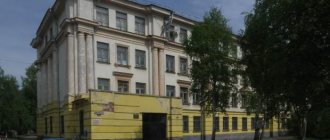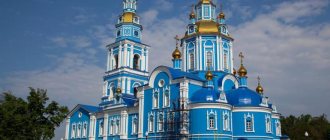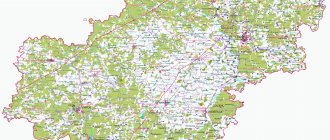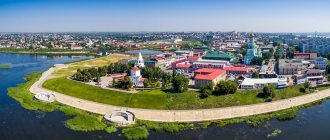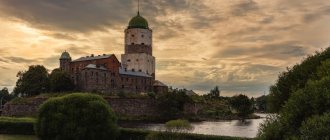Ulyanovsk region
includes 35
urban settlements
, including[1][2]:
- 6 cities, among which the following stand out: 3 cities of regional significance (highlighted in orange in the list) - within the framework of the organization of local self-government they form urban districts;
- 3 cities of district significance - included in districts - within the framework of the organization of local self-government, included in municipal districts;
What holiday is it today?
December 16, 2021, Thursday
Today are holidays, events: Events that happened on December 16 in the world, in different years Tomorrow: Day of Strategic Missile Forces Day of Employees of the State Courier Service Memorable date in the military history of Russia: Capture of the Ochakov fortress in 1788
Today is the Orthodox holiday of the Prophet Zephaniah. Reverend Savva of Storozhevsky, Zvenigorod. Martyr Angelis... Tomorrow: Great Martyr Barbara and Martyr Juliania of Iliopolis. Venerable John of Damascus...
Today is a national holiday: Day of World Silence and Silence... Tomorrow: Barbarian Day...
Seasons
Seasons, four periods of the year (spring, summer, autumn and winter) characterized by certain average temperatures. The period during which the Sun passes through one of these sectors is called the season. Spring in the Northern Hemisphere and autumn in the Southern Hemisphere begin when the Sun passes through the initial circle of declination and its right ascension is 0° (vernal equinox). Summer in the Northern Hemisphere and winter in the Southern Hemisphere occur when the sun's right ascension is 90° (summer solstice). Autumn in the Northern Hemisphere and spring in the Southern Hemisphere begin when the sun's right ascension is 180° (autumnal equinox). The beginning of winter in the Northern Hemisphere and summer in the Southern Hemisphere is considered to be the winter solstice, when the direct ascension of the Sun is 270°... Next: Seasons. Russian folk calendar. Monthly words...
General information about the Ulyanovsk region
Distinctive features . The Ulyanovsk region is officially (at the trademark level) considered the “Aviation Capital of Russia”. Indeed, here is the largest aviation enterprise, Aviastar-SP, which produces Tu-204 passenger aircraft, and is preparing to produce Ruslan transport aircraft. If we talk about mechanical engineering in general, it occupies 15% of the region’s gross structure. In addition to aircraft, the Ulyanovsk region produces world-famous air defense systems (Shilka, Tunguska-M, etc.) and no less famous UAZ SUVs. The nuclear innovation cluster is developed in Dimitrovgrad, the second largest city in the region.
Aircraft production at Avistar-SP. Photo by Andrey Pozdeev
Despite its small area, the Ulyanovsk region has given Russia and the world many celebrities. This is the leader of the revolution Vladimir Ulyanov (Lenin), Russian historian Karamzin, hero of the Patriotic War of 1812, poet, hussar and partisan Denis Davydov, writer Ivan Goncharov... And this is not a complete list! Moreover, the Ulyanovsk region is considered the birthplace of the hero of the Russian fairy tale - Kolobok.
Geographical location . The Ulyanovsk region is located in the center of the middle Volga region. It borders on the Samara, Saratov, Penza regions, as well as the republics of Mordovia, Chuvashia and Tatarstan. The Ulyanovsk region is part of the Volga Federal District.
The main river of the region is the Volga, which passes through the Kuibyshev Reservoir - the largest for this river. The Volga divides the territory of the region into two parts - the Right Bank and the Left Bank. On the right bank there is the Volga Upland, and the left bank (Trans-Volga region) is a lowland. Forests occupy about 25% of the territory of the Ulyanovsk region.
Bridge over the Volga. Photo by Ekaterina Kuleshova (https://fotki.yandex.ru/users/ekaterinacooleshova/)
Population. Once upon a time, the lands of the Ulyanovsk region were part of Volga Bulgaria. Turkic nomads and Finno-Ugric tribes lived here side by side. Now the national composition is as follows: 70% of the population are Russians, and then come the peoples of the Volga region: Tatars (11.59%), Chuvash (7.52%), Mordovians (3%).
Dimitrovgrad - the cultural capital of small nations of Russia
Currently, 1,274,487 people live in the Ulyanovsk region. 74% of them live in cities. Unfortunately, the natural population decline (-2.8 people per 1000 inhabitants) leads to the gradual extinction of the region. Over the past 20 years, the population has been steadily declining. But life expectancy is increasing every year: in 2012 it was 68.5 years.
Crime . The 66th place of the Ulyanovsk region in the ranking of regions by the number of crimes committed eloquently indicates that the criminal situation in the region is calm. Not many criminal offenses are recorded here, but high-profile corruption scandals occasionally appear.
The unemployment rate in the Ulyanovsk region almost exactly coincides with the average for the Russian Federation - 5.57%. The average salary in the region is 16.5 thousand rubles, and the highest salaries are for those involved in the extraction of fuel and energy minerals (34 thousand rubles)
Property value. The average cost of one square meter in Ulyanovsk is 44.5 thousand rubles. According to this indicator, it is comparable to Omsk, Krasnodar or Saratov. Prices for one-room apartments in Ulyanovsk start from 1.4 million rubles. Two-room apartments are much more expensive, around 2 million rubles.
On the streets of Ulyanovsk. Photo by koartemvl (https://fotki.yandex.ru/users/koartemvl/)
The climate of the Ulyanovsk region is temperate continental. The average temperature of the warmest month of July is +21°С, the average temperature of January is −7°С. In winter, Arctic and Atlantic air masses alternate here, so temperature changes are not uncommon. The average annual precipitation is 350-500 mm, depending on the area.
Folk calendar about every day
Every day one season always replaces another and this determines a person’s way of life. In connection with this, a folk calendar was formed in which there were practically no nameless, unmarked days. Every day was special, had its own purpose. All this was determined by climate conditions and astrological phenomena.
A calendar is a system for counting periods of time. The first calendars arose a long time ago, in ancient times, because there was a need to measure time. The word calendar comes from the Latin words caleo - to proclaim and calendarium - debt book. This is due to the fact that in Ancient Rome the beginning of each month was especially proclaimed, and because it was customary to pay debts on the first day of the month. Different peoples counted time differently. Some calendars are based on the changing phases of the moon - lunar calendars; in others - the change of seasons - sunny; in others, the length of the year was coordinated with the change of seasons, and the counting of months was associated with the phases of the Moon. Such calendars are called lunisolar.
In Rus', the calendar was called a monthly calendar. Every day, the month book covered the entire year of peasant life, “describing” day by day, month after month, where each day had its own holidays or weekdays, customs and superstitions, traditions and rituals, natural signs and phenomena. The cyclical nature of the calendar is reminiscent of human life, where spring is youth, summer is heyday, autumn is the time of harvesting fruits (it’s good if there are some, otherwise you can live your life without collecting fruits), winter is the time of wisdom and peace. This cyclicality and rhythm determined the way of life of the farmer. The folk calendar was an agricultural calendar, which was reflected in the names of the months, folk signs, rituals and customs. Even the determination of the timing and duration of the seasons is associated with real climatic conditions. Hence the discrepancy between the names of the months in different areas... Next: Folk calendar...
Map
| Ulyanovsk: maps |
Ulyanovsk: photo from space (Google Maps) Ulyanovsk: photo from space (Microsoft Virtual Earth)
| Ulyanovsk Nearest cities. Distances in km. on the map (in brackets along roads) + direction. Using the hyperlink in the distance , you can get the route (information courtesy of the AutoTransInfo website) | |||
| 1 | Isheevka | 15 (19) | NW |
| 2 | Novoulyanovsk | 18 (25) | IN |
| 3 | October | 20 (13) | IN |
| 4 | Attics | 30 (31) | IN |
| 5 | Bolshoye Nagatkino | 34 (40) | NW |
| 6 | Old Maina | 46 (61) | NE |
| 7 | Sengilei | 47 (67) | SE |
| 8 | Maina | 54 (106) | SW |
| 9 | Terenga | 66 (68) | YU |
| 10 | Mullovka | 67 (69) | IN |
| 11 | Staroe Drozhzhanoe (Republic of Tatarstan) | 70 (86) | NW |
| 12 | Buinsk | 72 (94) | WITH |
| 13 | Tetyushi | 74 (99) | NE |
| 14 | Dimitrovgrad | 79 (85) | IN |
| 15 | Bulgarian | 83 (124) | NE |
| 16 | Shemursha (Chuvash Republic - Chuvashia) | 84 (91) | NW |
| 17 | Starotimoshkino | 86 () | SW |
| 18 | Veshkaima | 86 (108) | Z |
| 19 | Karsun | 91 (85) | Z |
| 20 | New Maina | 91 (97) | IN |
| 21 | Batyrevo (Chuvash Republic - Chuvashia) | 96 (111) | NW |
| 22 | Shygyrdan (Chuvash Republic - Chuvashia) | 97 () | NW |
| 23 | Kuzovatovo | 97 (107) | SW |
| 24 | Yalchiki (Chuvash Republic - Chuvashia) | 97 (124) | WITH |
| 25 | Apastovo (Republic of Tatarstan) | 99 (128) | WITH |
| 26 | New Malykla | 101 (109) | IN |
| 27 | Shigony (Samara region) | 105 (165) | YU |
| 28 | Surskoye | 109 (120) | Z |
| 29 | Barysh | 111 (142) | SW |
| 30 | Tolyatti | 111 (184) | SE |
a brief description of
Located on the Volga Upland, on the banks of the Volga (Kuibyshev Reservoir) and Sviyaga rivers, 893 km east of Moscow. River port. Railway junction lines and highways.
The climate is moderate continental. The average temperature in January is -14, July is +20. Precipitation is over 400 mm per year.
Territory (sq. km): 622
Information about the city of Ulyanovsk on the Russian Wikipedia site
Historical sketch
In 1648, during the construction of the Sinbirsk abatis line, the city of Sinbirsk was founded as its starting point. The name of the feature and the city is based on its location in the Sinbir Mountains area, which received its name from the Sinbir settlement (20 km to the south on the left bank of the Volga). Its name is based on the name of the Tatar prince Sinbar from the times of the Golden Horde or the Kazan Khanate. But the use of the suffix -sk allows us to more likely see the formation from a common noun, possibly from an ethnonym.
The fortress was founded on the steep bank of the Volga, called Venets (height more than 120 m), by okolnichy and governor B.M. Khitrovo and clerk G. Kunakov.
In 1670 it was besieged by the troops of Stepan Razin. In 1773 and 1774, Emelyan Pugachev was kept in custody in the Sinbirsky prison.
The name Sinbirsk was used in charters and acts until the end of the 18th century, and in popular usage it remained until the end of the 19th century. From the end of the 18th century. The Simbirsk uniform receives official recognition.
In 1708 it was assigned to the Kazan province, from 1717 - in the Astrakhan province, in 1728 again in the Kazan province, the center of the Sinbir province. Since 1780, the center of the Simbirsk governorship (since 1796 - Simbirsk province).
In the 19th century one of the major centers of trade in bread, fish, livestock, and timber in the Volga region.
In the 1790s. The first public theater was opened in Simbirsk in the 1840s. a theater school was built.
In 1856, in the provincial city of Simbirsk, Simbirsk province, there were 26 churches, 2613 houses, 677 shops.
In 1898 it was connected by railway with Inza, at the beginning of the 20th century. - with Bugulma.
In 1924, it was renamed Ulyanovsk after the name of local native V.I. Ulyanov-Lenin (1870-1924).
Since 1928 it was part of the Middle Volga region (then the region), since 1936 - into the Kuibyshev region. Since 1943, the center of the Ulyanovsk region.
During the Great Patriotic War of 1941-45, a number of industrial enterprises were evacuated to Ulyanovsk.
Municipal indicators
| Index | 1990 | 1999 | 2001 | 2003 | 2005 |
| Demography | |||||
| Number of births, per 1000 population | 14.8 | 7.2 | 8 | 9.1 | 8.8 |
| Number of deaths, per 1000 population | 8.4 | 11.3 | 12.5 | 13.9 | 13.6 |
| Natural increase (decrease), per 1000 population | 6.4 | -4.1 | -4.5 | -4.8 | -4.8 |
| Standard of living of the population and social sphere | |||||
| Average monthly nominal accrued wages, rub. | 0.27 | 1153.9 | 2410 | 4345.8 | 6702.8 |
| Average housing area per inhabitant (at the end of the year), sq.m. | 15.7 | 18.7 | 19.1 | 20.3 | 20.8 |
| Number of preschool institutions, pcs. | 254 | 153 | 140 | 133 | 129 |
| Number of children in preschool institutions, thousand people | 44.4 | 18.2 | 17.4 | 17 | 18.1 |
| Enrollment of children in preschool educational institutions (at the end of the year), as a percentage of the number of children of the corresponding age, % | 60.8 | 59.7 | |||
| Number of daytime educational institutions (at the beginning of the school year), pcs. | 91 | 107 | 108 | 108 | 109 |
| Number of students in daytime educational institutions, thousand people | 85 | 97.3 | 87.6 | 74.8 | 61.7 |
| Number of doctors, people. | 3144 | 3588 | 3540 | 3415 | 3252 |
| Number of nursing staff, people. | 9295 | 11137 | 10784 | 11259 | 10418 |
| Number of hospital institutions, pcs. | 26 | 31 | 30 | 28 | 31 |
| Number of hospital beds, thousand units | 9.3 | 9.8 | 9.2 | 8.7 | 8.4 |
| Number of medical outpatient clinics, pcs. | 48 | 56 | 60 | 62 | 67 |
| Capacity of medical outpatient clinics, visits per shift, thousand units. | 16.6 | 18.2 | 18.4 | 18.3 | 19.6 |
| Number of registered crimes, pcs. | 7403 | 9710 | 10349 | 8380 | 13698 |
| Persons who committed crimes were identified, persons. | 6402 | 5919 | 3891 | 4770 | |
| Economy, industry | |||||
| Number of enterprises and organizations (at the end of the year), pcs. | 10286 | 12338 | 14637 | 17136 | |
| Number of operating enterprises by type of activity: mining (at the end of the year), pcs. | 6 | ||||
| Number of operating enterprises by type of activity: manufacturing (at the end of the year), pcs. | 572 | ||||
| Number of operating enterprises by type of activity production and distribution of electricity, gas and water (at the end of the year), pcs. | 112 | ||||
| Volume of shipped goods of own production by type of mining (in actual prices), million rubles. | 3.5 | ||||
| Volume of shipped goods of own production by type of manufacturing (in actual prices), million rubles. | 34230.3 | ||||
| Volume of shipped goods of own production by type of production and distribution of electricity, gas and water (in actual current prices), million rubles. | 8847.4 | ||||
| Construction | |||||
| Volume of work performed by type of activity “Construction” (until 2004 - volume of work performed under construction contracts), million rubles. | 0.4 | 1790.1 | 2917.4 | 2906.9 | 3594.8 |
| Commissioning of residential buildings, thousand sq.m. of total area | 345.8 | 139.5 | 124.4 | 112.7 | 202.7 |
| Commissioning of residential buildings, apartments | 1963 | 1556 | 1528 | 2652 | |
| Commissioning of preschool institutions, places | 2938 | 0 | 0 | 0 | 0 |
| Commissioning of educational institutions, places | 4322 | 0 | 0 | 0 | 0 |
| Commissioning of hospital facilities, beds | 300 | 0 | 0 | 0 | 0 |
| Commissioning of outpatient clinics, visits per shift | 0 | 30 | 0 | 40 | |
| Transport | |||||
| Number of bus routes (in intracity traffic), pcs. | 58 | 47 | 45 | 28 | 23 |
| Number of tram routes, pcs. | 9 | 17 | 17 | 16 | 14 |
| Length of operational tram tracks (at the end of the year), km | 53.1 | 59.3 | 59.3 | ||
| Number of trolleybus routes, pcs. | 7 | 9 | 9 | 7 | 7 |
| Length of operational trolleybus lines (at the end of the year), km | 26 | 27.3 | 27.3 | ||
| Number of passengers transported by buses per year (in intracity traffic), million people. | 116.5 | 60.1 | 42.5 | 14.2 | 8.3 |
| Number of passengers transported by trams per year, million people. | 122.9 | 178 | 180.4 | 132.1 | 70.8 |
| Number of passengers transported by trolleybuses per year, million people. | 14.9 | 29.2 | 29 | 29.3 | 13.5 |
| Connection | |||||
| Number of telephone sets of the city public telephone network, thousand units. | 79.7 | 130.7 | 146.2 | 200 | 234.4 |
| Number of residential telephone sets of the city public telephone network, thousand units. | 39.9 | 92.6 | 100.8 | 154.7 | 193.9 |
| Number of payphones of the city telephone network (including universal ones), pcs. | 1292 | 1162 | |||
| Trade and services to the population | |||||
| Retail trade turnover (in actual prices), million rubles. | 1 | 7159.8 | 12398 | 21141 | 27784 |
| Retail trade turnover (in actual prices), per capita, rub. | 1.6 | 10342 | 18134 | 32390 | 43317.8 |
| Index of physical volume of retail trade turnover, % compared to the previous year | 110 | 101.4 | |||
| Index of physical volume of public catering turnover, % compared to the previous year | 82.3 | 91.4 | |||
| Number of stores, pavilions (at the end of the year), pcs. | 526 | 532 | |||
| Sales area of shops, pavilions (at the end of the year), sq.m. | 32007.1 | 39610 | |||
| Volume of paid services to the population (in actual prices), million rubles. | 0.186 | 1472.1 | 3409.7 | 6130.5 | 9992.3 |
| Volume of paid services to the population (in actual prices), per capita, rub. | 0.3 | 2126 | 4987 | 9393 | 15579 |
| Volume of household services to the population (in actual prices), million rubles. | 0.043 | 318.9 | 634.4 | 684.1 | 833.9 |
| Volume of household services to the population (in actual prices), per capita, rub. | 0.067 | 460.7 | 928 | 1048 | 1300 |
| Investments | |||||
| Investments in fixed assets (in actual prices), million rubles. | 0.648 | 1141 | 2051.4 | 3925.1 | 4713.4 |
| Share of investments in fixed assets financed from budgetary funds in the total volume of investments, % | 9.6 | 10.9 | 11.9 | 17 | |
Data sources:
- Regions of Russia. Main characteristics of the constituent entities of the Russian Federation: statistical collection. Goskomstat of Russia. - M:, 2003.
- Regions of Russia. Basic socio-economic indicators of cities. Statistical collection. Rosstat. - M:, 2005.
- Transport in Russia: Statistical collection. Goskomstat. - M:, 2003. pp. 110, 112, 120, 122
- Transport in Russia: Statistical collection. Rosstat. - M:, 2005. pp. 117, 119, 127, 129
- Regions of Russia. Basic socio-economic indicators of cities. 2006. Statistical collection. Rosstat. - M:, 2006. p. 255
Culture, science, education
Institutes: pedagogical, polytechnic, agricultural.
Higher Aviation School of Civil Aviation. Branches of Moscow State University and Samara Economic Institute.
Theatres: drama, puppet theaters.
Museums: local history (founded in 1895), art, history of civil aviation.
The poet N.M. was born in the city. Yazykov, writers D.V. Grigorovich, A.I. Goncharov.
Monument to N.M. Karamzin (1845, sculptor S.I. Galberg) - a native of the Simbirsk province. Monuments: “M.A. Ulyanov with his son Volodya”, to Karl Marx (1921), V.I. Lenin (1940), V. Ulyanov - high school student (1954), I.N. Ulyanov (1957), N. Narimanov (1973).
Architecture, sights
Buildings: public places (1807, architect A.D. Zakharov), Assembly of the Nobility (1838-47, architect I.A. Benzeman), Yazykov House (early 19th century), military gymnasium (1877, architect Zalessky) , Public Assembly (1910), Peasant Land Bank (1911, architect F.O. Livchak), house of I.A. Goncharova (1916, architect A.A. Shode), etc.
In the 1960-70s. The central part of Ulyanovsk was reconstructed, where the Lenin Memorial Zone was created (1967-70), including elements of old Simbirsk (mainly houses associated with the life of the Ulyanov family in the city) and the ensemble of the Lenin Memorial Center.
River station (1965), railway station (1970)
| Population by year (thousands of inhabitants) | |||||||
| 1811 | 13.3 | 1956 | 183 | 1992 | 656.4 | 2011 | 614.8 |
| 1840 | 17.7 | 1959 | 205.9 | 1996 | 680.2 | 2012 | 614.4 |
| 1856 | 26.5 | 1962 | 239 | 1998 | 675.6 | 2013 | 615.3 |
| 1863 | 24.9 | 1967 | 294 | 2000 | 667.4 | 2014 | 616.7 |
| 1897 | 41.7 | 1970 | 351.1 | 2001 | 663.6 | 2015 | 619.5 |
| 1913 | 54.7 | 1973 | 395 | 2003 | 635.9 | 2016 | 621.5 |
| 1914 | 55.2 | 1976 | 429 | 2005 | 623.1 | 2017 | 624.5 |
| 1923 | 68.7 | 1979 | 464.0 | 2006 | 617.2 | 2018 | 626.5 |
| 1926 | 70.6 | 1982 | 497 | 2007 | 611.7 | 2019 | 627.9 |
| 1931 | 68.9 | 1986 | 566 | 2008 | 607.0 | 2020 | 627.7 |
| 1939 | 103.8 | 1989 | 625.2 | 2010 | 602.8 | 2021 | 625.5 |
Fishing calendar for every day
The fishing calendar should not be taken as an absolutely indisputable truth. Fish biting is greatly influenced by a whole range of natural factors, as well as the influence on the nature of man himself. You must not forget that the fish’s bite depends and is determined not only by the calendar dates and biological cycles of their life, reflected in the calendar, but also, no less, by the state of their habitat; the bite also depends on weather conditions: air and water temperatures, cloudiness, wind direction and strength, etc... Next: Fishing calendar...
Orthodox calendar about every day
Orthodox calendar: Orthodox, Church and Christian holidays.
The church year is an alternation of weekdays and holidays. On weekdays, a person is called to work “by the sweat of his brow to earn his bread.” Holidays are given in order to feel liberation, to rise above the bustle and routine of the world, to feel involved in the highest of worlds, “where there are no illnesses, sorrows and sighs, but endless life.” Since ancient times, holiday cycles have been associated with the seasons. The pagans associated them with the worship of the forces of nature, the cult of which in the Old Testament was replaced by gratitude to the Creator for the universe. And although the connection between holidays and the seasons has not completely lost its power, since God is present in everything, in the plant and animal world, in human works, it nevertheless faded into the background, giving way to a spiritual foundation built on the Sacred Scriptures. The history of Orthodox holidays dates back to the times of the Old Testament. Each of the Orthodox holidays is dedicated to the remembrance of the most important events in the life of Jesus Christ and the Mother of God, as well as the memory of saints... Next: Orthodox calendar...
Russian folk calendar for every day
The word “sign” comes from the word “notice”, i.e. observe. As a result of observing what happens around a person every day, he accumulates life experience. This knowledge was passed down from generation to generation, carefully preserved and people trusted it as a sacred book. Many signs have come to us from the depths of centuries without losing their knowledge. Each of us is free to choose: to dismiss all this as an absurd superstition or to take a closer look at the signs and take the centuries-old experience of generations more seriously. Most of us, when taking exams, ask them to scold them, boasting about some kind of good fortune or luck, spit so as not to jinx them or knock on wood, take a detour if a black cat crossed the road, are afraid of the number 13 and much more. And who among us does not have lucky things, numbers? Who has never resorted to the help of fate at least once in their life, who has not believed in secrets? It’s as if everything connected with signs is hidden somewhere deep in our subconscious. Often we remember them mechanically, unconsciously, or just as a joke. But, undoubtedly, the signs contain a lot of accurate knowledge and practical wisdom of our ancestors. They cover all the characteristic, often difficult to perceive, natural phenomena. Signs have preserved a lot of what was in old folk holidays and customs; they help predict the weather, grow crops... Next: Folk signs...
see also
- Ulyanovsk region
- Cities of Russia
| [ + ] Cities by regions of Russia | |
| Cities of the North-West (NWFD) | St. Petersburg (and its cities) • Leningrad region (historical Staraya Ladoga) • Arkhangelsk region • Vologda region • Kaliningrad region • Karelia • Komi • Murmansk region • Nenets Autonomous Okrug • Pskov region |
| Cities of the Volga region (Volga Federal District) | Bashkortostan • Volgograd region • Kalmykia • Kirov region • Mari El • Mordovia • Nizhny Novgorod region • Orenburg region • Penza region • Perm region • Samara region • Saratov region • Tatarstan • Udmurtia • Ulyanovsk region • Chuvashia |
| Cities of Southern Russia (SFD) | Sevastopol (including Inkerman) • Republic of Crimea • Adygea • Astrakhan region • Krasnodar region • Rostov region |
| Cities of the North Caucasus (NCFD) | Dagestan • Ingushetia • Kabardino-Balkaria • Karachay-Cherkessia • North Ossetia - Alania • Stavropol Territory • Chechen Republic |
| Cities of the Urals (Ural Federal District) | Kurgan region • Sverdlovsk region • Tyumen region • Khanty-Mansi Autonomous Okrug - Yugra • Chelyabinsk region • Yamalo-Nenets Autonomous Okrug |
| Cities of Siberia (Siberian Federal District) | Altai Republic • Altai Territory • Irkutsk Region • Kemerovo Region • Krasnoyarsk Region • Novgorod Region • Novosibirsk Region • Omsk Region • Tomsk Region • Tyva • Khakassia |
| Cities of the Far East (FEFD) | Amur Region • Buryatia • Jewish Autonomous Region • Trans-Baikal Territory • Kamchatka Territory • Magadan Region • Primorsky Territory • Sakha (Yakutia) • Sakhalin Region • Khabarovsk Territory • Chukotka Autonomous Region |
| see also | Cities of the DPR, LPR, Transnistria, South Ossetia • Regions of Russia • Cities of Russia |
Holiday calendar, dates and events of the year
All state and professional holidays in Russia, including significant World and International holidays, and other equally interesting holidays and events about every day.
The holiday has always kept pace with the history of mankind. Social time can be divided into three types: everyday life (weekdays), weekends and holidays. Everyday life is a series of practices repeated day after day and every day (work). Weekends are regular breaks from the rush of everyday life. It is believed that on weekends a person should restore his strength after working days. Day off, non-working day. A holiday is a day of celebration established in honor or in memory of someone or something. A day or series of days celebrated by the church in memory of a religious event or saint... Next: Calendar...
Distance tables of countries of the world
- Distance between cities of Azerbaijan
- Distance between cities in Armenia
- Distance between cities in Belarus
- Distance between cities in Georgia
- Distance between cities in Kazakhstan
- Distance between cities in Mongolia
- Distance between Russian cities
- Distance between cities in Turkmenistan
- Distance between cities in Turkey
- Distance between cities of Uzbekistan
- Distance between cities in Ukraine
- Distance between cities in Eurasia
- Distance between European cities
- Distance between CIS cities
Prayer book, Orthodox prayers for every day
Prayer is the most powerful means for healing all illnesses - both physical and mental. Prayers can be laudatory or grateful, petitionary and repentant. If we have offended God, sinned, we must ask Him for forgiveness, that is, repent. Such prayers are called repentant prayers. If everything is fine with us, if we and our loved ones are healthy and prosperous, if we have a place to live, something to wear, something to eat, we must glorify and thank God for this. Such prayers are called praise or thanksgiving. If some misfortune, illness, trouble or need happens, you need to ask God for help. Such prayers are called petitionary... Next: Orthodox prayers...
Zodiac, astrological, eastern calendar. Zodiac signs
In ancient times, to establish the calendar, priests used knowledge of the positions of all the planets. Before the reform of Peter 1, the New Year was celebrated on the Day of the Autumn Equinox. On this day, according to ancient legend, the most peaceful treaty was concluded between the Great Race (ancient Slavs) and the Great Dragon (ancient Chinese) and it was approximately 7518 years ago... For the ancient Slavs, the calendar month corresponded to the lunar cycle from new moon to new moon, taking into account such Thus, the relationship of the entire annual cycle with astronomical and natural phenomena. There was no coherent calendar system. The main natural phenomena are still considered to this day to be the days of the solar equinox and solstice - the Slavic holidays Maslenitsa, Kupala, Ovsen and Kolyada. But during the time of Peter 1, all ancient Slavic calendars were abolished and a new Western European calendar from the Nativity of Christ (Julian calendar) was introduced, while the beginning of the calendar was moved to January 1. The Julian calendar (old style) did not take leap days into account and accumulated one extra day every 128 years. After the October Revolution in 1918, the Gregorian calendar (new style) was introduced in Russia, according to which an amendment of 13 days was introduced. The calendar of the ancient Slavs was based on two planets: the Sun and the Moon. And now they don’t use anything at all. The calendar has become static. There is no such thing as the calendar, it turns out, resting on some planet. Nobody even knows about it. There are just some standard numbers, there are months and holidays. The calendar is based on the Sun and Moon. Why is this so? Because these two luminaries influence the Earth. The Earth revolves around the Sun, and the Moon revolves around the Earth. And these two luminaries create the atmosphere on the planet. From here the calendar is built... Next: Astrological calendar...
Cities[ | ]
| № | Name | district[5] / city of regional significance[6] | population (persons) | founding/first mention | city status | coat of arms | former names |
| 1 | Barysh | Baryshsky district | ↘15 541[3] | 17th century | 1954 | ||
| 2 | Dimitrovgrad | Dimitrovgrad (GO) | ↘113 472[3] | 1698 | 1926 | until 1972 - Melekess | |
| 3 | Inza | Inzensky district | ↘17 245[3] | 1897 | 1946 | ||
| 4 | Novoulyanovsk | Novoulyanovsk (GO) | ↘13 778[3] | 1957 | 1967 | Kremenki | |
| 5 | Sengilei | Sengileevsky district | ↘6221[3] | 1666 | 1943 | until 1780 - Pokrovskoye | |
| 6 | Ulyanovsk | Ulyanovsk (GO) | ↘625 462[4] | 1648 | 1648 | until 1780 - Sinbirsk until 1924 - Simbirsk |
Dream books online, interpretation of dreams
A dream book is nothing more than an interpreter of dreams and dreams, a translator of dreams. Since ancient times, people have been using dream books; dreams have always been given great importance, and people have often noticed the prophetic properties of some dreams. The dream book can become your faithful assistant every day and throughout your life, thanks to the dream interpreter you can always make the right decisions, the dream book will help you resist temptations in time, and will warn you against wrong steps and frivolous actions. Further…
